William Kennedy Shaw explained in his book the enormous amount of special and not so special equipment the LRDG needed. The rations, weapons and equipment were managed by "Shorty" Barrett, the supply officer. among the supplies mentioned by Shaw were:
- Chapplies and boots
- Special fuel and oil for the Wacos
- Ammunition for all the weapons
- Mills bombs, land mines, gelignite, sticky bombs, detonators, time pencils, fuse
- Special rations for the Indian patrols
- Smoke generators, camouflage nets, paint
- 44 gallon fuel cans, jerry cans, water cans.
- Tents
- And anything else the patrol needed or might need when running across escaped POWs or stranded airmen.
The task of keeping the patrols well equipped was enormous. Below are some particulars of the patrol equipment.
Patrol Equipment
Trucks
There is a fuller treatment of the trucks used by the LRDG in a separate section. All of the trucks used by the LRDG possessed specialty equipment used in the conduct of their missions. Such items as sun compasses and sand channels are described below.
In General:
Initially the vehicles were modified civilian vehicles, later they were CMP or Canadian Military Pattern vehicles and the ever popular Willys MB Jeep. Depending on the mission of the Patrol vehicles, they had a weight rating of either 15 CWT or 30 CWT. CWT is an archaic British payload weight term for 100 pounds. So a 15 CWT vehicles is capable of towing 1,500 pounds or a 3/4 ton vehicle.
Drive Train:
For the most part, the LRDG preferred 4X2 vehicles. This means the vehicle had four wheels but only had power going to two of the wheels. A 4x4, such as a Jeep, means the vehicle has four wheels and power can go to all four wheels. The reason the LRDG preferred the two wheel drive trucks is because they tended to have less weight and used less gas. Gas was heavy and took up valuable space.
Painting (Camouflage)
While most photographs make it difficult to tell how the trucks were painted, personal recollection seems to point that 8th Army Dark Yellow was far from the standard that most current modeling enthusiasts prefer today. In the sandy desert regions desert pink and a variety of pastel shades of light green, blue* and, purple were also used. The reason these colors were used is they were effective in blending in with the heat and haze of the desert sand. In the more rocky regions of the desert, mid-stone, slate blue, and grey were commonly used. There was no standard camouflage scheme per se , however, each there were standards within each patrols. Most vehicles were painted in mass at a rear area. I have received personal notes from LRDG member stating that the vehicles often showed up very pink!
Besides the colours shown to the right, Black and varying shades of faded black also appeared on the vehicles. As you can suspect, all the paints used would also fade in the bright the desert sun.
* There has been extensive discussion over the use of light blue. The Caunter camouflage pattern is said to have used slate gray which over time faded to a pale blue. This may be the case of the light blue on vehicles but personal recollections from LRDG members claim light blue was indeed used on patrol vehicles.
Look under Camouflage Examples for possible paint schemes
Markings
Each patrol carried markings unique to the patrol. For instance, T patrol, a New Zealand patrol had a small kiwi painted on the right front of the truck's bonnet. on the left front was a "Maori" nickname which began with the letter "T". R and W patrols had a similar policy with naming their vehicles. Y Patrol, on the other hand carried names of Musketeers on their Right front fender. According to Ian Chard who heard it from his father, a member of "Y" Patrol, this was a done more as a private joke between patrol members. Later the trucks took the names of Race Horses.
G Patrol was drawn from the Guards units. As such, their marking consisted of red and blue or black and red bars with lettering superimposed in white. G patrol did not name their vehicles, but the patrol commander flew a small flag from his vehicle when he was riding in it.
Look in Officer Commanding for known and possible vehicle markings
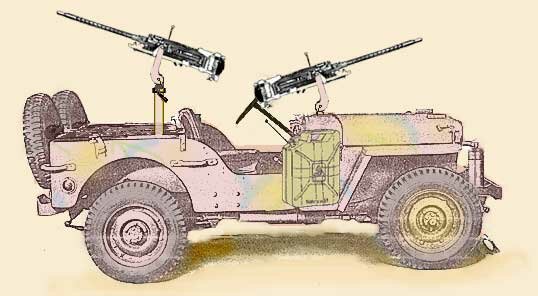
LRDG Jeep with two air-cooled .30 Brownings.
Color Chips
Below are a few sample colors used in painting the trucks First if the common color used by modelers. In parenthesis is the name used in official publications:
(note, due to different computer settings, not all colors are going to appear the same from computer to computer.)

8th Army Desert Yellow
(Canadian Sand)

US Army Desert Sand
(Light Sand)

USAF Desert Pink
(Desert Pink)

Azure
(Light Blue)

Light Green

Mid-stone

Purple Brown

Slate Grey
(Silver Grey)

Portland Stone
Sun Compass
Sun Compasses were developed earlier in the 20th Century and used in aircraft and on ships. When an ordinary magnetic compass is placed next to a large metal mass it doesn't always point to magnetic north, this is a problem in ships and aircraft. There are various ways to compensate for this effect used in ships, but it was found that these methods were unsatisfactory when used in aircraft, and so the sun compass was developed. The compass is not magnetic at all, when you align it with the sun it points north, (the compass contains a clock which enable it to track the sun across the sky). There is an entire chapter on this device in "From Lodestone to Gyrocompass" by H Hitchens and W. May, published by Hutchinson.
Because there are few features to get bearings from in the Desert, the LRDG pioneered the use of Sun Compasses for navigating the arid regions. One of the chief duties of the LRDG was to act as pathfinders for larger units. They also trained navigators from various units in the art of navigating the desert with a sun compass
(In fact British Soldiers often referred to being in the desert as "on the blue" a term comparing the desert to the featureless ocean.)
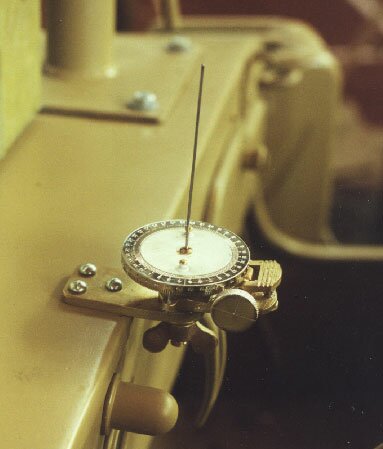
LRDG style sun compass Photo provided by the LRDG Preservation society
Maps
Along with the Sun compass, The LRDG used the latest, RAF navigational tables, which were specially obtained by Prendergast from the Navigation branch at Air Ministry to navigate the desert.
LRDG Binoculars
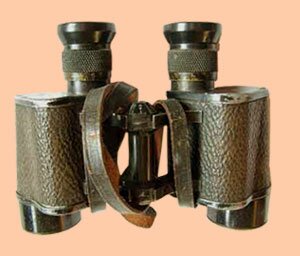
Wray 6x30 (RAF)
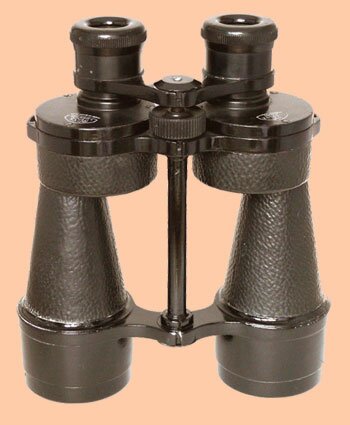
Ross 7x50 (Army

Deinst 6x30 (DAK)
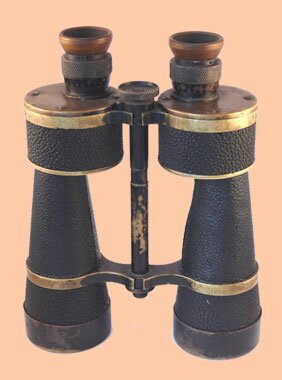
Deinst 10x50 (DAK)
The workhorse binoculars for all major armies in World War II were 6X30 Binoculars manufactured by various optical companies. These same 6X30 binoculars were also the workhorse optics for the LRDG.
Several British optical companies provided binoculars for the armed forces, any of which could have wound up in the hands of the LRDG.
- Kershaw, Leicester, Ross, and Taylor-Hobson were principle suppliers for the Army
- Wray was a principle supplier for the Air Force.
- Barr & Stroud produced binoculars for the Royal Navy.
Other smaller companies also produced binoculars for the British. It is possible that American binoculars produced by Bausch & Lomb and others may have been supplied through lend lease.
The 6X30 binoculars were designated Binocular No.2 and were further identified by a Mk number (II or III) and the manufacturers name. As with many items produced in bulk for the military, the binoculars were manufactured to a specific standard and for the most part they all look similar. In some cases the manufacturers can only be told apart by their distinct manufacturers stamp.
The 6x30 indicates that the binoculars have a magnification six times greater than the human eye and an objective lens thirty millimeters in diameter. Thus the “6” means things would appear six times closer. The size of the objective lenses relates to how much light is refracted to the eye. A larger objective lens will result in a brighter sharper image.
A step up from the standard 6X30 binoculars were the No.5 binoculars. The No. 5 were also further identified by Mk Numbers (I -IV) and a manufacturers name. No. 5 binoculars had a magnification of seven with a fifty millimeter objective lens. The 7X50 binoculars provided far better magnification and a much brighter image. However, No.5 binoculars were less common than the standard issued binoculars as they were more often used in sea service and by higher ranking officers.
While the British binoculars were robust and did the job, German binoculars manufactured by Dienstglas and using Zeiss optics were considered far superior. German tank and platoon commanders were issued 6X30 Dienstglas binoculars and most company commanders and above were issued the more powerful 7X50 Dienstglas binoculars. The highly prized optics often found their way into the hands of British soldiers.
Theodolite
One of the principles jobs of the LRDG was to survey the desert and find and map passable routes for units to move through. Without accurate maps, the British would not really know where the enemy was or how to reach them. Without pinpointing items found on the actual ground with the maps provided a patrol could not function. The principle surveying tool was the Theodolite or surveyor's transit.
The theodolite is mounted on an adjustable wooden tripod and then made plumb or level using plumb bobs and to leveling bubbles.

Example of British WWII Military Transit.
In this case the Director, No. 5 Mk1
Prismatic Compass
The British Prismatic Marching Compass was made of brass and had a mother of pearl compass card (dial) which glowed in the dark. Originally issued to officers, it was probably one of the finest compasses in use at the outbreak of World War II. As with many military compasses it could be read in degrees or mils. As most know there are 360 degrees in a circle. There are 6,400 mils in a circle or 17.78 mils per degree. This allowed the experienced user the ability to plot very accurately using the aiming posts and prism that were attached to the compass. This compass was used with the sun compass in navigating of the vast desert.
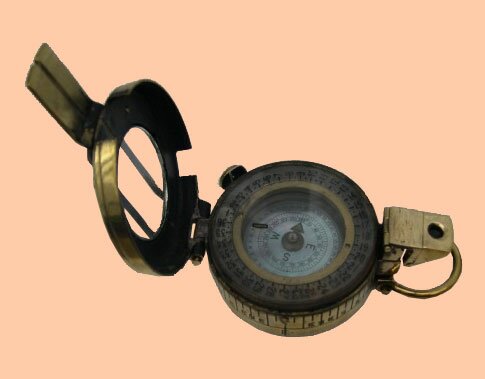
Prismatic Marching Compass
Patrol Radio, Wireless Set No. 11.
The patrol's main link to the GHQ was the No. 11 Wireless Set.
Wireless Set No. 11 was a portable transceiver developed in 1938. It was a general purpose low power set. It was a commonly employed vehicle station (truck/AFV), ground station and occasionally animal pack station. It's frequency range was 4.2-7.5MHz. MO control. RF output 0.6-4.5W. R/T and CW. It's normal maximum range was only about 20 miles unless rigged for long range use.
When set up for long range use the set could could use a six fit rod antenna or the end fed Wyndom Aerial slung between two 17 foot tall wooden poles, creating a long range directional antenna.
The patrols relied heavily on Morse communications and as such their radio operators were drawn from New Zealand's Divisional Cavalry and the Royal Corps of Signals. Personnel had to have experience with either the Merchant Marines, or the Marconi Company Long Range Morse Procedure. Later the radio operators were selected from or trained by IWOS-The Irregular Wireless Operators School which was run by G(R) and GHQ, MEF.
The wireless set was located on the right hand side of the Radio Vehicle behind the driver, in a special compartment cut into the side of the truck. (Earlier vehicles required the side of the truck's bed to be dropped in order to access the radio.)
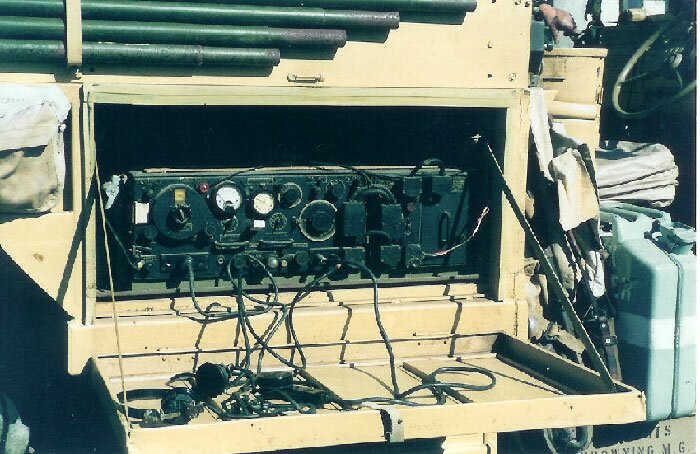
Wireless Set No. 11. mounted in a restored 30 CWT truck in Australia.
Note the antenna poles above the radio. Photo courtesy, the LRDG Preservation Society.
Windom Antenna
The Windom antenna was first described by amateur Short Wave radio operator, L.G. Windom in September 1929. It consists of a half-wave dipole antenna at its lowest frequency band, with a single-wire feeder connected off-center, dividing the antenna into pieces of .36L and .64L, where L (ft) = 468/f (MHz). The single wire feeder is attached to the antenna at its dividing point by a balun (balancer/unbalancer).
So to break it down in less-technical terms:
- Diplole Antenna: a wire stretched between two poles. The poles need to be a sufficient distance above the ground in order to allow for long distance transmission. You probably do not won't to be under the antenna
- Balun: A device that allows for balanced/unbalanced connection of a transmitter. In short one line is coming from the radio, the Balun allows that line to be split and have two lines come off from it. Think of it as a sort of line splitter but it is more technical than that.
- Insulators: The antenna is insulated from the two poles holding it airborne. This is done by connecting it to the poles with non-conductive material.
While the antenna appears to directional, it is not. It is omni-directional, that is it transmits and receives in every direction.
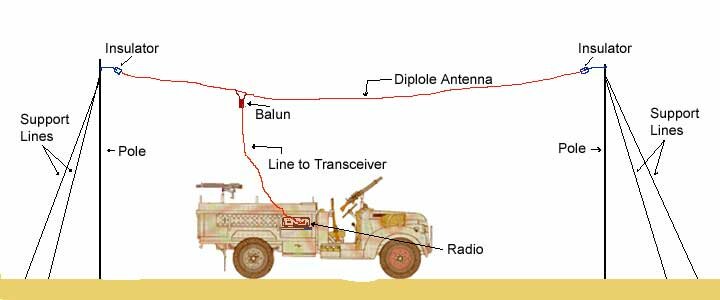
Wireless Truck w/Windom Antenna set up for transmission.
Very Lights (Flare Guns)
One Method of signaling from a far distance was the use of flare pistols. The pistols could be used to initiate an attack, help in locating a lost member or patrol, assist in aerial or ground recognition of units or a number of other signaling needs
The pistol and holster to the right is the Webley & Scott 1 inch flare pistol. A brass veteran of WWI, it continued to see use throughout WWII.
The name Very Light comes from the name of Edward W. Very (1847-1910). He was a U.S. naval officer who came us with a system of signals using colored pyrotechnic flares fired from a special pistol. The flares were used for signaling or to temporarily illuminate an area. Verey light and verylight or erroneous but often accepted spellings of the correct name very light.
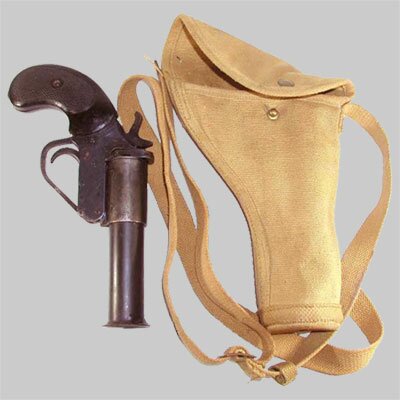
Sand Channels and Sand Mats
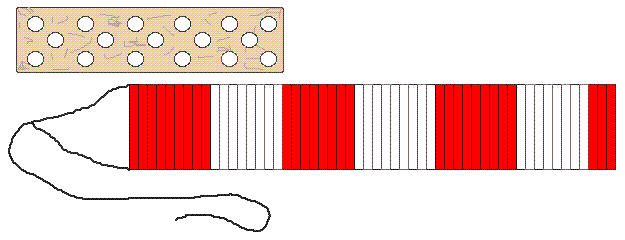
All LRDG patrol vehicles were supplied with "Unsticking Gear". This gear included a variety of pioneer tools plus sand channels and sand mats.
The sand mats were long pads made of reinforced heavy canvas. One side of the sand mats were a sand in color (or painted to match the vehicles), the other side was a series of red and white stripes. This is because the sand mats doubled as air markers. In the event the LRDG needed an aerial resupply the sand mats would be laid out like a signal T for the approaching aircraft.
The sand channels were a section of PSP (Perforated Steel Planking). PSP was used extensively in World War II for the construction of airfields and roads.
The way these devices worked: Once a vehicle was stuck the sand mats or channels would be placed in front of the stuck wheels that provided the traction. As the wheels spun the mats or channels would be fed under the wheels which would then displace the weight of the vehicle over a larger area and unstick the vehicle. It sound easy but in practice it was extremely labor intensive.
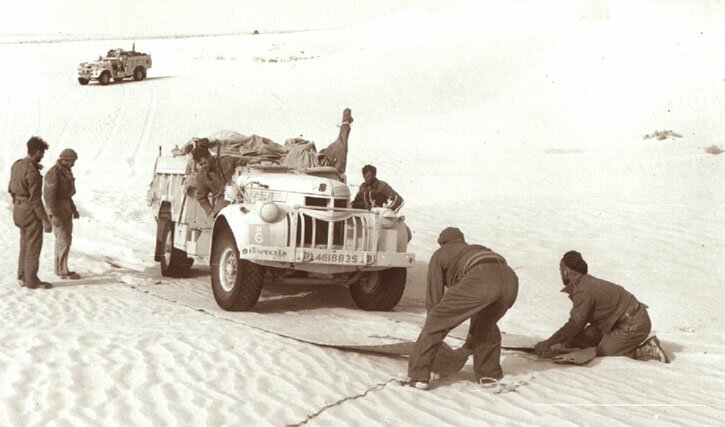
Using sand mats to aid crossing loose sand.
The mats shown do not appear to have a red and white side
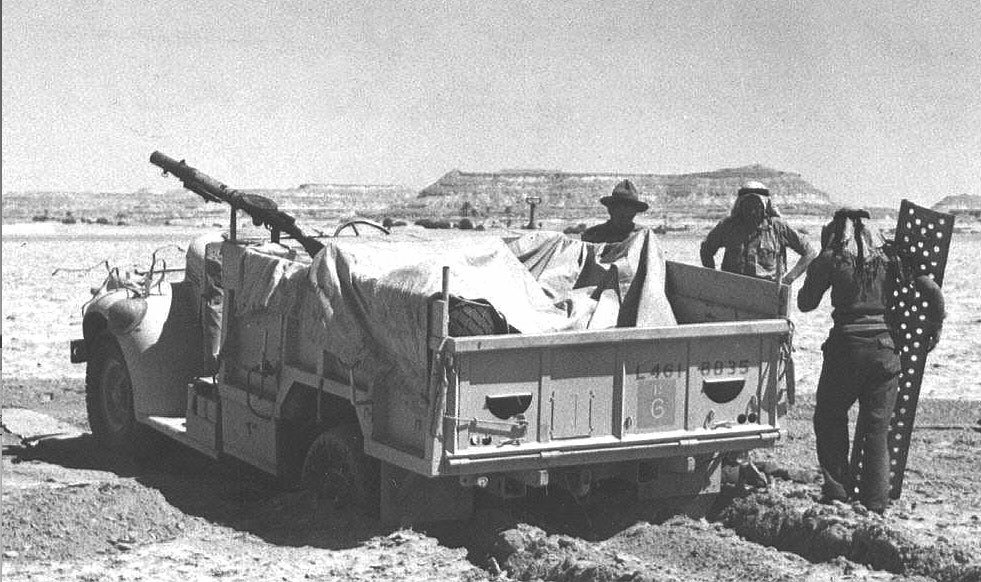
Breaking out the sand channels for some deep sand recovery. Note the Lewis Gun behind the passenger side seat.
Aerial Identification
Patrols carried special panels that were used on missions to identify themselves to friendly aircraft. Lloyd Owen mentions the use of them in his book but does not describe them in any way except to say they were not standard vehicle markings but the friendly aircraft were to be briefed of their description. This was to prevent the enemy from waving a British flag. The problem is the aircraft didn't always get briefed or failed to see the panels. One of the realities of working behind the enemy lines was you had a good chance of being attacked by your own aircraft. Besides these panels, sources say the LRDG used the following Aerial Identifications.
Roundels
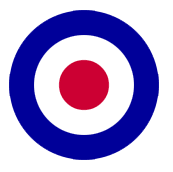
Probably one of the most important items carried by the patrol was a wooden roundel. This roundel was used to assist with identification from the air. Working behind the lines meant that the patrols not only had to worry about the enemy but also friendly aircraft. For this reason a wooden disc was carried with British Roundel on one side, and Swastika in a white circle on the other.
These marking were typically painted on the hoods of vehicles so that aircraft could identify the occupants easily from the air. Once a truck spotted an aircraft they would quickly determine if it was a friend or foe and then display the roundel on the bonnet of the truck From the air the marking would appear painted on. This was more deceiving than simply waving a flag. With the roundel displayed the patrol would then wave to the aircraft and hope for the best.
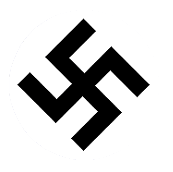
Flags were also carried by the patrols and used in a manner similar to the roundels above.
One possibility to aid in the confusion was to wave an Italian flag when approached by a German pilot, in hopes that the Pilot would be less familiar with Italian vehicles. In any case, due to the nature of the war in the Western Desert, Axis forces used a lot of captured British equipment and no patrol was ever safe from any approaching aircraft.
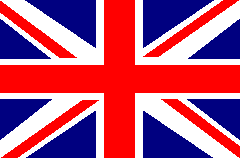
United Kingdom
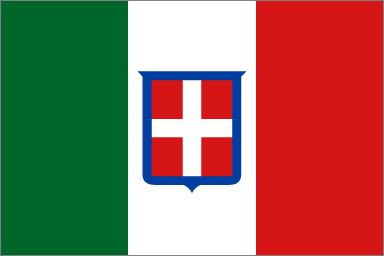
Fascist Italy
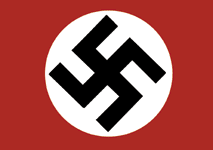
Nazi Germany
Signal Flags
As mentioned, only the W/T truck had a radio and it was used to contact LRDG HQ. to keep in contact between vehicles on patrol The LRDG used signal flags. Every vehicles had a set a signal flags and the crews used a modified form of semaphore to signal between vehicles. Sources say they were used like the old time ships of sail which means they may have been run up a pole. It is more likely the the flag handle was placed in one of the numerous mounts located on the trucks or waved by hand.
This is very similar to the hand signals used by foot patrols. The LRDG used flags that would make the signal visible for a longer distance.
For instance a green flag deployed by the pilot vehicle may tell the patrol to rally around for instructions. Another flag signal was used to command the patrol to deploy in single file while another signal would give directions to travel.
The only flag colors mentioned in books are green and red. There is also mention of the two tone diagonal flag, perhaps the traditional red and yellow semaphore flags
While I've not seen a source describing it, night time commands may have given using a torch (flashlights), with a red or green lens cover. This was common practice for other units that operated patrols during WWII.
Fuel Cans
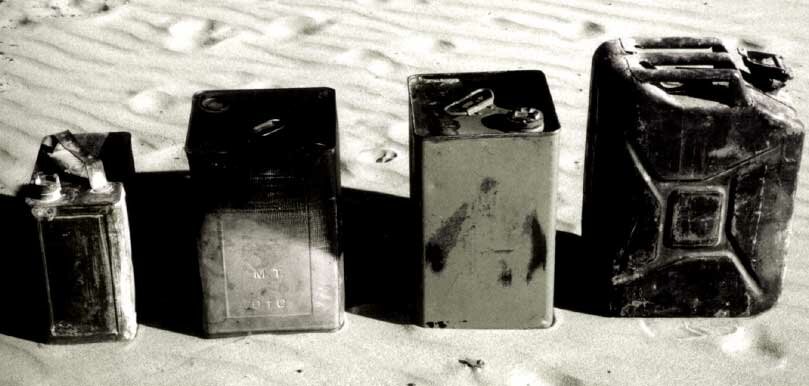
Jerry Cans
The German 20 liter petrol/water cans. The cans later copied by Americans and became the standard military issue 5 gallon fuel cans. The American fuel cans were readily adopted by the British. The Germans typically painted a white cross on their cans used for drinking water. This practice was sometimes used by allied forces. However, American fuel and water cans had different type caps which lessened the likelihood of confusing the two.
Furthermore, American fuel cans had the type of fuel (gas, diesel, oil, etc) stenciled in black paint near the top of the can while water cans were stenciled in black letters near the bottom of the can. Water cans were also had a light yellow enamel coating on the inside to prevent corrosion.
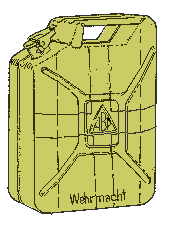
Petrol Can
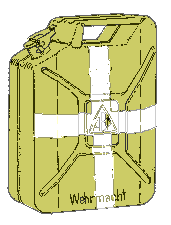
Water Can
Flimsies (Flimsys)
Imagine is you will, a paper thin metal cube designed to carry liquids and you have a Flimsy.
The flimsy held four imperial gallons (about five U.S. gallons) of liquid and it was the standard container used by the British military when hostilities broke out. They leaked, they were easily damaged, and they were prone to corrosion. On top of that, it was practically impossible to reuse them more than one or twice. In fac tthey were often discarded after use to make room in the trucks.
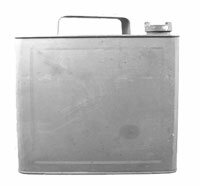
They could not be air-dropped. As a matter of fact they would probably split open if they were dropped only a few feet. They also were not easy to carry due to the carrying handle and the bulky shape.
Flimsies held four Imperial gallons. There were also similar cans that held one or two gallons. These smallers sizes are sometimes called flimsies but are more appropriately called oil cans. The smaller size cans were normally rectangular and were sturdier than the flimsies.
Camouflage Nets
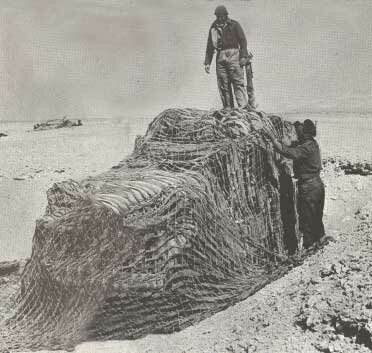
Crew applying nets
(The image above has been modified for clarity An LRDG soldier has been airbrushed from the foreground.)
Camouflage nets are issued to crews of motorized and mechanized forces; as such all LRDG vehicles were issued nets. The number of nets per vehicles is depended on the size of the vehicles. Supporting poles are also issued with the nets, however many photos often show the nets simply pulled over LRDG trucks without the use of supporting poles. This was probably done during short stops. When patrols remained in a position for a longer time, more appropriate camouflage and concealment took place.
The nets used were issued for use in the Mediterranean Theater. Despite this, the LRDG felt they were inadequate for desert patrols and added additional hessian (burlap) strips to their nets. In keeping with the lessons learned, the additional strips were pink and light olive in color. These strips were added to the nets at LRDG headquarters in Cairo.
Personal accounts by LRDG members claim that when the nets were placed on vehicles, the enemy could pass within a few hundred of yards and not see the vehicles.
Spare Tyres
Spare tires were a necessity in the desert and patrols could not have too many. The tyre size depended somewhat on the vehicle being used but in general they were 16 inch low pressure sand tires. This meant that the air would be removed from the tyre to lessen ground pressure in loose sand and then the tires would be reinflated once harder ground was found.
The heat of the desert as well as rocks and a bumpy ride led to continual tyre punctures. The tires used inner tubes as opposed to the more common tubeless tires of today. Still, to fix a flat required breaking down the tire and, patching or replacing the inner tube and then remounting the tyre. Of course depending on how bad the puncture, the tyre may be unfixable. Imagine attempting to jack up a three ton truck in loose sand. It was not uncommon for a patrol to instead brace the truck so it wouldn't sink and then dig a hole under the bad tyre and rather than attempt to jack up a vehicle.
The combination of heat and grinding surface of the sand reduce the life of tires dramatically. This led to blow outs which would create holes in the tires and inner tubes that were too big to patch. In this even a new tire would and inner tube would replace the old one. The crews carried both tires on rims and loose replacement tires. Often, spares would be covered with heavy paper or cloth to keep them out of the direct rays of the sun and to aid in camouflaging the large black circles.
Lloyd Owen described a patrol which was aborted simply due to a bad batch of tires. The patrol had taken on dozens of spares and was to the point of leaving working vehicles behind just to order to have enough spares to press on before Prendergast ordered him to return to base camp. The entire unit had been given a bad lot of tyres that would have been fine in Cairo or perhaps even in a regular military unit but not capable of enduring the rocks, heat, and punishing sun of the Sahara. Such was the necessity of a quality tyre.
